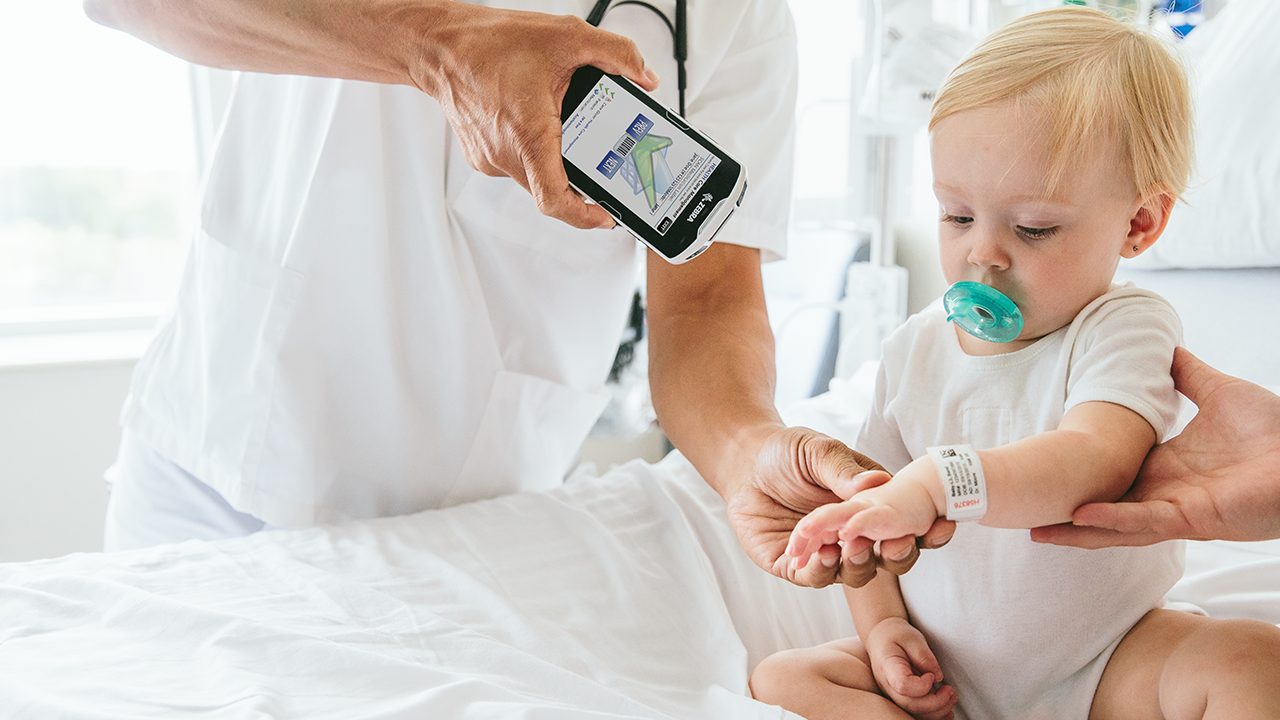Transform retail operations with Zebra’s retail technology solutions, featuring hardware and software for improving inventory management and empowering teams.
Streamline operations with Zebra’s healthcare technology solutions, featuring hardware and software to improve staff collaboration and optimise workflows.
Enhance processes with Zebra’s manufacturing technology solutions, featuring hardware and software for automation, data analysis, and factory connectivity.
Zebra’s transportation and logistics technology solutions feature hardware and software for enhancing route planning, visibility, and automating processes.
Zebra's public sector technology solutions enhance decision-making, streamline operations, and safeguard communities with advanced software and rugged hardware.
Zebra's hospitality technology solutions equip your hotel and restaurant staff to deliver superior customer and guest service through inventory tracking and more.
Zebra's market-leading solutions and products improve customer satisfaction with a lower cost per interaction by keeping service representatives connected with colleagues, customers, management and the tools they use to satisfy customers across the supply chain.
Empower your field workers with purpose-driven mobile technology solutions to help them capture and share critical data in any environment.
Zebra's range of mobile computers equip your workforce with the devices they need from handhelds and tablets to wearables and vehicle-mounted computers.
Zebra's desktop, mobile, industrial, and portable printers for barcode labels, receipts, RFID tags and cards give you smarter ways to track and manage assets.
Zebra's 1D and 2D corded and cordless barcode scanners anticipate any scanning challenge in a variety of environments, whether retail, healthcare, T&L or manufacturing.
Zebra's extensive range of RAIN RFID readers, antennas, and printers give you consistent and accurate tracking.
Choose Zebra's reliable barcode, RFID and card supplies carefully selected to ensure high performance, print quality, durability and readability.
Zebra's location technologies provide real-time tracking for your organisation to better manage and optimise your critical assets and create more efficient workflows.
Zebra's rugged tablets and 2-in-1 laptops are thin and lightweight, yet rugged to work wherever you do on familiar and easy-to-use Windows or Android OS.
With Zebra's family of fixed industrial scanners and machine vision technologies, you can tailor your solutions to your environment and applications.
Zebra’s line of kiosks can meet any self-service or digital signage need, from checking prices and stock on an in-aisle store kiosk to fully-featured kiosks that can be deployed on the wall, counter, desktop or floor in a retail store, hotel, airport check-in gate, physician’s office, local government office and more.
Discover Zebra’s range of accessories from chargers, communication cables to cases to help you customise your mobile device for optimal efficiency.
Zebra's environmental sensors monitor temperature-sensitive products, offering data insights on environmental conditions across industry applications.
Adapt to market shifts, enhance worker productivity and secure long-term growth with AMRs. Deploy, redeploy and optimize autonomous mobile robots with ease.
Enhance frontline operations with Zebra’s AI software solutions, which optimize workflows, streamline processes, and simplify tasks for improved business outcomes.
Zebra Workcloud, enterprise software solutions boost efficiency, cut costs, improve inventory management, simplify communication and optimize resources.
Keep labour costs low, your talent happy and your organisation compliant. Create an agile operation that can navigate unexpected schedule changes and customer demand to drive sales, satisfy customers and improve your bottom line.
Drive successful enterprise collaboration with prioritized task notifications and improved communication capabilities for easier team collaboration.
Get full visibility of your inventory and automatically pinpoint leaks across all channels.
Reduce uncertainty when you anticipate market volatility. Predict, plan and stay agile to align inventory with shifting demand.
Drive down costs while driving up employee, security, and network performance with software designed to enhance Zebra's wireless infrastructure and mobile solutions.
Explore Zebra’s printer software to integrate, manage and monitor printers easily, maximising IT resources and minimising down time.
Make the most of every stage of your scanning journey from deployment to optimisation. Zebra's barcode scanner software lets you keep devices current and adapt them to your business needs for a stronger ROI across the full lifecycle.
RFID development, demonstration and production software and utilities help you build and manage your RFID deployments more efficiently.
RFID development, demonstration and production software and utilities help you build and manage your RFID deployments more efficiently.
Zebra DNA is the industry’s broadest suite of enterprise software that delivers an ideal experience for all during the entire lifetime of every Zebra device.
Advance your digital transformation and execute your strategic plans with the help of the right location and tracking technology.
Boost warehouse and manufacturing operations with Symmetry, an AMR software for fleet management of Autonomous Mobile Robots and streamlined automation workflows.
The Zebra Aurora suite of machine vision software enables users to solve their track-and-trace, vision inspection and industrial automation needs.
Zebra Aurora Focus brings a new level of simplicity to controlling enterprise-wide manufacturing and logistics automation solutions. With this powerful interface, it’s easy to set up, deploy and run Zebra’s Fixed Industrial Scanners and Machine Vision Smart Cameras, eliminating the need for different tools and reducing training and deployment time.
Aurora Imaging Library™, formerly Matrox Imaging Library, machine-vision software development kit (SDK) has a deep collection of tools for image capture, processing, analysis, annotation, display, and archiving. Code-level customisation starts here.
Aurora Design Assistant™, formerly Matrox Design Assistant, integrated development environment (IDE) is a flowchart-based platform for building machine vision applications, with templates to speed up development and bring solutions online quicker.
Designed for experienced programmers proficient in vision applications, Aurora Vision Library provides the same sophisticated functionality as our Aurora Vision Studio software but presented in programming language.
Aurora Vision Studio, an image processing software for machine & computer vision engineers, allows quick creation, integration & monitoring of powerful OEM vision applications.
Adding innovative tech is critical to your success, but it can be complex and disruptive. Professional Services help you accelerate adoption, and maximise productivity without affecting your workflows, business processes and finances.
Zebra's Managed Service delivers worry-free device management to ensure ultimate uptime for your Zebra Mobile Computers and Printers via dedicated experts.
Find ways you can contact Zebra Technologies’ Support, including Email and Chat, ask a technical question or initiate a Repair Request.
Zebra's Circular Economy Program helps you manage today’s challenges and plan for tomorrow with smart solutions that are good for your budget and the environment.

Switched at Birth?
Imagine one of the worst nightmares that parents could experience: another baby is mistaken for their own during the course of care at a hospital or, worse, during the discharge process. Unfortunately, it’s not inconceivable, as these parents know:
- In 2008, two infants were switched during circumcision procedures at a hospital in Illinois.
- In 2012, a newborn was breastfed by the wrong mother at a Minneapolis hospital.
- In 2018, a couple in West Virginia claimed that a local hospital gave them the wrong baby.
While incidents like these are rare, infant mix-ups at hospitals continue to be a potential risk. A study out of Pennsylvania found an average of nearly two newborn misidentification events reported daily. These are nightmares that parents should never experience.
Of course, when it comes to patient identification, babies do present unique challenges. After all, they can’t tell you who they are. And, as the Pennsylvania Patient Safety Authority noted, “they often share similar or identical birth dates, similar medical record numbers, and, in the case of twins and multiple births, common surnames.” It’s difficult to fit and secure wristbands on their tiny wrists. They wiggle and move about, making wristbands difficult to read.
This is further complicated by the fact that many hospitals use naming conventions that can create confusion. A recent survey by the American Academy of Pediatrics found that, of 339 neonatal intensive care units, 81.7 percent used nondistinct naming conventions such as “BabyBoy” or “BabyGirl”.
The Joint Commission: Looking out for patient safety
Since 2002, the National Patient Safety Goals (NPSG) set by The Joint Commission, the not-for-profit organization that accredits and certifies nearly 21,000 healthcare organizations and programs in the United States, have established standards for ensuring patient safety in all healthcare settings. At the top of the NPSG agenda remains the mandate to “use at least two patient identifiers when providing care, treatment, and services.”
Though the two-identifier mandate was established well over a decade ago, a January 2019 iteration of the NPSG included a new Element of Performance that requires Joint Commission-accredited hospitals that provide labor and delivery services to use specific naming conventions to identify newborn patients.
Specifically, the naming conventions must include:
- Mother’s first and last name and the newborn’s gender
- A second identifier added to banding with two body-site identifications and barcoding
The mandate also recommends that hospitals alert staff to these new requirements in situations in which there are newborns in the facility with similar names.
How to Confirm That Your Newborn Identification Solution Meets New Mandate Requirements
Barcoded wristbands have long served as the primary patient identification tool for hospitals. However, it is important to remember that not all wristbands are the same. When evaluating whether or not your hospital’s existing patient identification system complies with this new newborn identification mandate, you should thoroughly assess your wristbands to ensure they feature critical attributes, such as:
- A design and shape that enables them to lie flat on the wrist for easy scanning.
- Soft material that ensures infant comfort.
- Accommodation for reading swaddled infants.
- Lamination that protects patient data (text and barcodes) from moisture and hand sanitizers.
- Adhesive closures to prevent tampering.
- Wristband extenders to accommodate a wide range of wrist sizes.
- A foolproof system for providing matching wristbands to the mother or birthing partner.
If your current wristbands do not meet all of these criteria, then it may be time to consider alternative solutions that satisfy both baby and mother identification (and comfort) requirements.
###
Editor’s Note:
Did you know that Zebra’s new LaserBand2 Labor and Delivery Wristband patient identification system were designed to ease compliance with the Joint Commission’s new mother-baby identification mandate? You can learn more about these wristband solutions here.

Shannon Swanson
Shannon Swanson is Manager, Product Management, Healthcare Supplies Portfolio at Zebra Technologies.
Zebra Developer Blog
Zebra Developer Blog
Are you a Zebra Developer? Find more technical discussions on our Developer Portal blog.
Zebra Story Hub
Zebra Story Hub
Looking for more expert insights? Visit the Zebra Story Hub for more interviews, news, and industry trend analysis.
Search the Blog
Search the Blog
Use the below link to search all of our blog posts.
Most Recent
Legal Terms of Use Privacy Policy Supply Chain Transparency
ZEBRA and the stylized Zebra head are trademarks of Zebra Technologies Corp., registered in many jurisdictions worldwide. All other trademarks are the property of their respective owners. ©2025 Zebra Technologies Corp. and/or its affiliates.






